The Friday night football brought us to the Riverside Stadium where Jonathan Woodgate’s Middlesbrough hosted Michael O’Neill’s Stoke City in the EFL Championship fixture. For both teams, it was a relegation ‘six-pointer’ with the Potters having been stranded in the relegation zone since August, while the Riversiders were only three points above their rivals before this game sitting in 20th place.
The home team has been the lowest-scoring team so far this season averaging 0.86 goals per game having scored only 19 goals in total. Luckily for them, their opponents from Stoke were not much better in this metric. O’Neill’s side has been averaging a slightly higher goal per game ratio of 1.09, having scored 24 goals in total prior to this game.
The visitors dominated the first half in terms of possession and total attempts, 58% and 7 respectively. However, the majority of Stoke’s attacks lacked cutting edge and incisiveness in the final third with 5 out of 7 shots performed from outside the box. On the other hand, Middlesbrough played very safely in the first 45 minutes, managing only a single attempt at goal. The Riversiders averaged only 0.19 attacks per minute compared to Stoke’s 0.53 in the first half.
After a quite uneventful first half, the scenery changed after the half-time. The game saw two goals being scored in the first 12 minutes of the second half with a substitute Lewis Wing adding a third of the game and his side’s second to seal an unexpected win for the hosts.
This tactical analysis will take a closer look at both teams’ game strategies that lead to such a game outcome.
Lineups
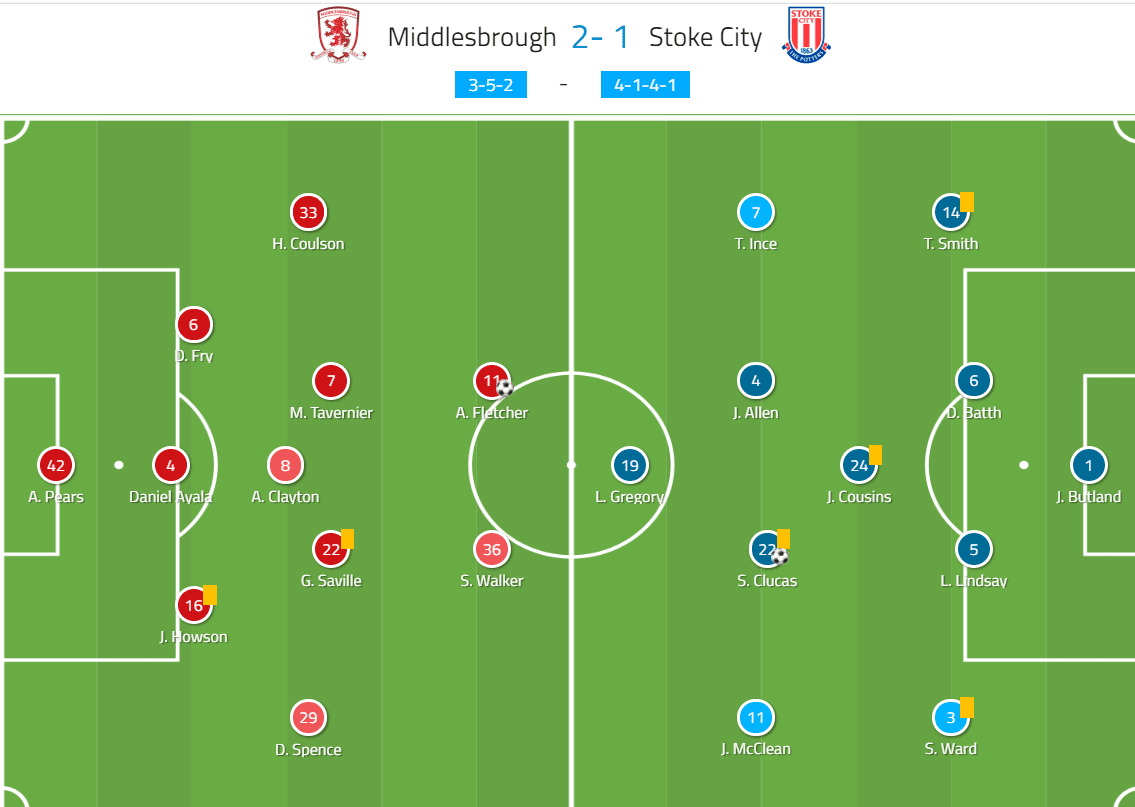
The Boro manager Woodgate went for a 3-5-2 formation in this game. Aynsley Pears was placed in goal with a back three ahead of him consisting of Jonny Howson (right side), Daniel Ayala (middle) and Dael Fry (left side). The two wing-backs were Djed Spence (right) and Hayden Coulson (left). In front of the back-line, Adam Clayton was the one who provided even more defensive stability with George Saville and Marcus Tavernier being the two more advanced centre-midfielders. The goal threat came from Ashley Fletcher and Stephen Walker.
Woodgate’s opponent on the night O’Neill lined-up his team in a 4-3-3 formation. Jack Butland started in goal and was protected by a back four of Tommy Smith, Danny Batth, Liam Lindsay and Stephen Ward. Jordan Cousins was chosen to protect the back four in a holding midfield role with Joe Allen and Sam Clucas playing higher up the pitch. James McClean provided width on the left-side with Tom Ince doing the same on the right. Lee Gregory was Stoke’s lone man upfront for the night.
Stoke’s intention to attack down the right
From the first minute of the game, the away team’s tactics were to attack down the right flank. The first few attempts mainly saw Ince being the target man after one of the centre-backs would switch the play with a cross-field pass. The Englishman had the third-highest xG ratio in a team (0.23); however, the situations where Stoke’s right inverted winger was left to play one against one did not deliver much joy to the away supporters. The pacey winger tried to dribble past the opponents 12 times but succeeded in only 33% of those attempts.
Below we can see an example of the above-mentioned tactics employed by Stoke. The left-sided centre back Lindsay switches the play to the right side with a big majority of Middlesbrough players sitting very deep in their own half.
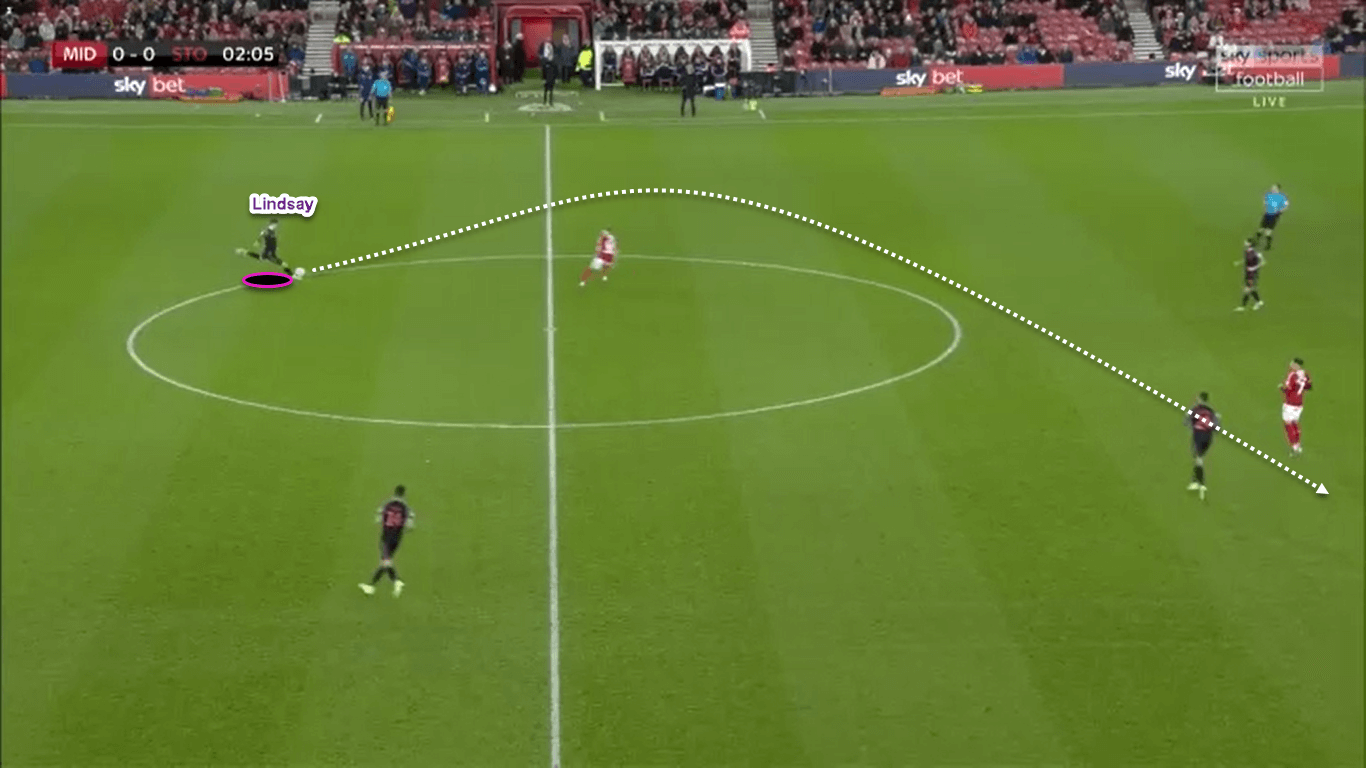
The pass finds Ince near the sideline in a one against one situation with the opposition player. A massive open field (dark green) ahead of him suggests Stoke’s intention to have their most dangerous player in one against one situations attacking the space with more freedom and improvisation.
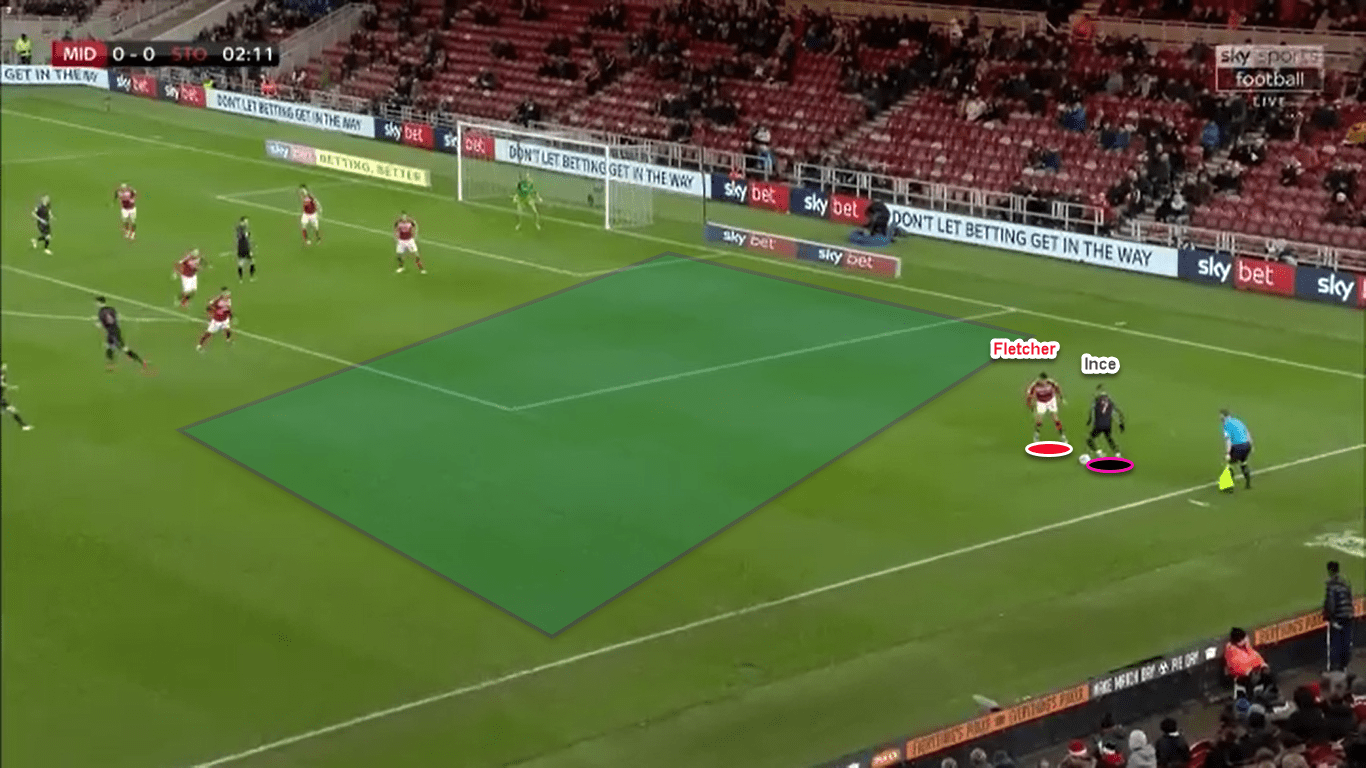
Below is another example where Ince was left on his own to try and beat the opposition defenders using his trickery and dribbling skills.
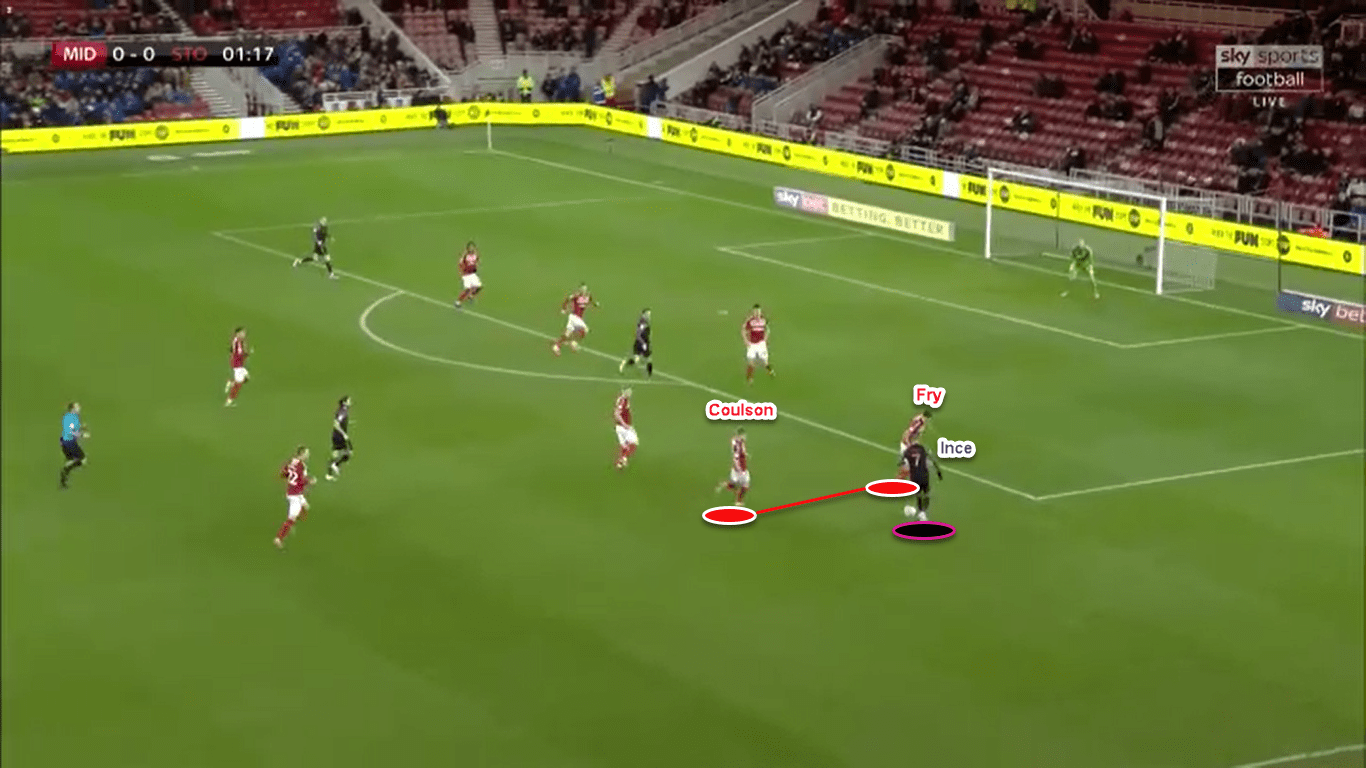
With Ince struggling to make a significant impact on the game by himself, deeper into the first half a reoccurring scene started to emerge. Three right-sided players were the main participants of that scene. The right-back Smith, the right-sided centre-midfielder Allen and already many times mentioned Ince. In most cases, they tried to work their way out of the triangle by performing short passing combinations in a way that one of the Middlesbrough players would lose the track of one of them. Thus, one of the three Potters would break free and be set to deliver a cross into the box. However, as it will be shown later, all that possession and passing combinations down the right flank were hardly successful in terms of creation of goal scoring opportunities.
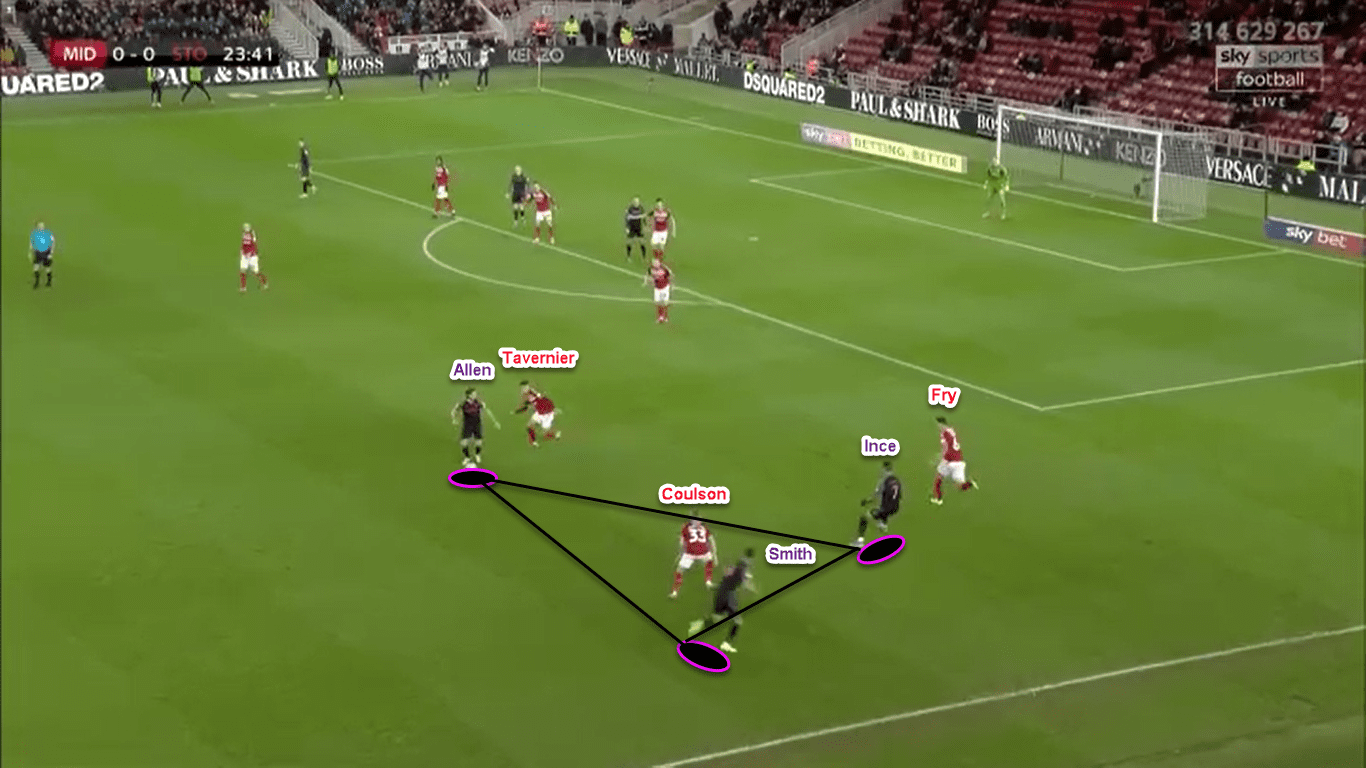
The aforementioned triangle comprised of Ince, Allen and Smith is illustrated below. Here, in this specific scene, Ince moved into an inside channel to free up space on the right-wing for the right-back Smith. Allen, acting as a supplier in this scenario, finds his teammate but the whole play lacks penetration and incisiveness since Middlesbrough players covered their respected opponents very well. Usually, it was the Boro left-sided centre-back Fry who would step out to mark Ince with the left wing-back Coulson keeping an eye on Smith and Tavernier being responsible for Allen.
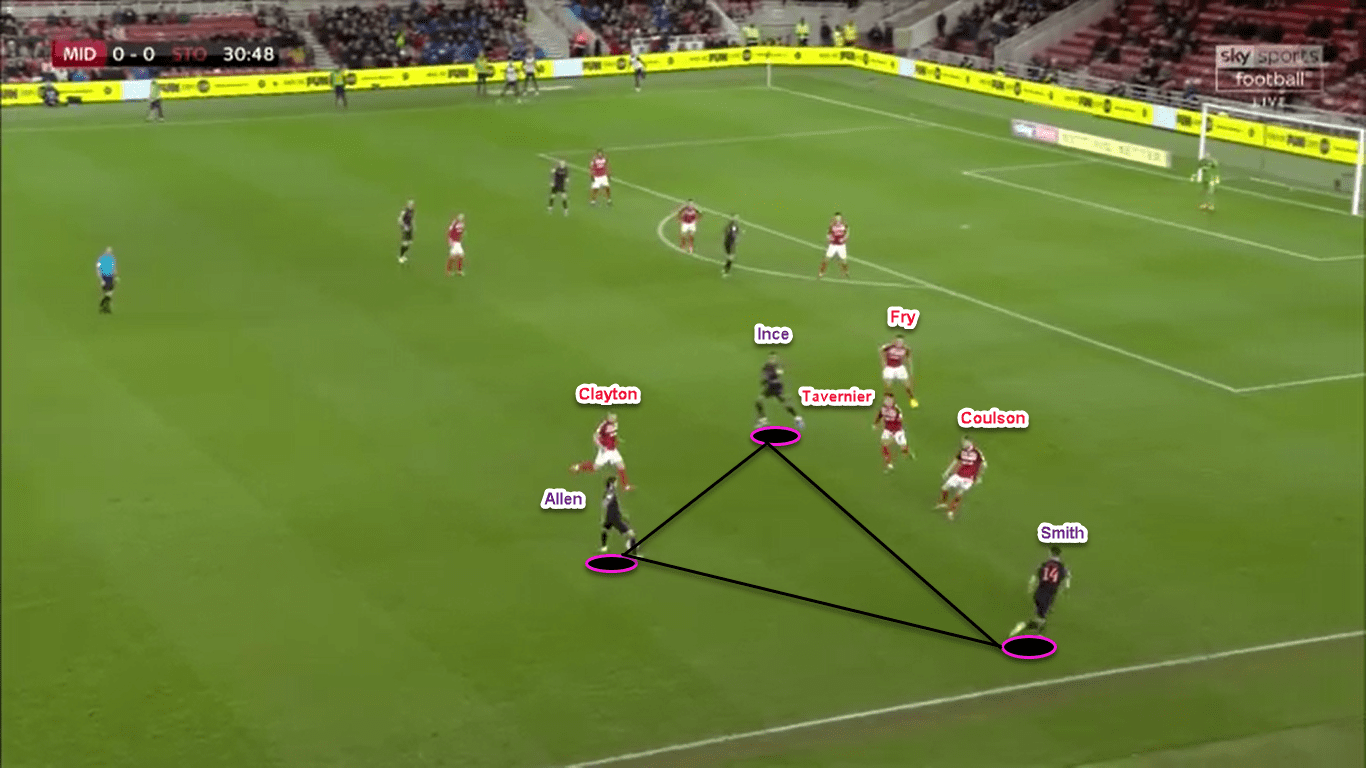
The above-displayed images can be backed up with the passing map. As it can be clearly seen, the strongest connection belongs to the three aforementioned players: Allen (no.4), Smith (no.14), Ince (no.7). Another thing that should be taken into account is the proximity of those three players. All three of them stayed close to each other to lower the possible risk of losing the ball and as mentioned already to work their way out up the field by freeing up one of the three.
An interesting trend can be spotted on the opposite wing as well. Even though only 28% of the visitors’ attacks came down the left flank, a similar triangle comprised of Clucas (no.22), McClean (no.11) and Ward (no.3) can be seen. It indicates that O’Neill’s game plan is more about playing in wing-spaces and half-spaces rather than through the centre of the pitch.
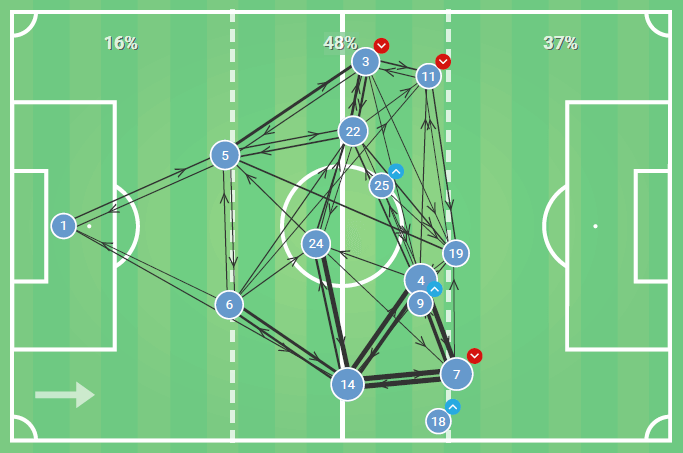
An idea to work in triangles on the right-wing sounded great first since the players that operate on the right flank for Stoke are good in possession and technically competent. Nevertheless, all that pretty possession turned into nothing as the Potters lacked incisiveness when combining down the right-wing. The movements and interchanges between the three usually were too predictable that ended up in hopeful crosses into the box.
As it can be seen in the example below, the triangle did not quite work out in this case for Stoke. Consequently, since neither Allen nor Ince made any penetrative runs into the channels in behind the defence, Smith had the only option but to deliver a hopeful cross into the box where Stoke were usually outnumbered. O’Neill’s side performed 21 crosses in the first half and only two of them were successful. Only eight were delivered into the box in the second half but the accuracy remained poor, only two reached the destination again.
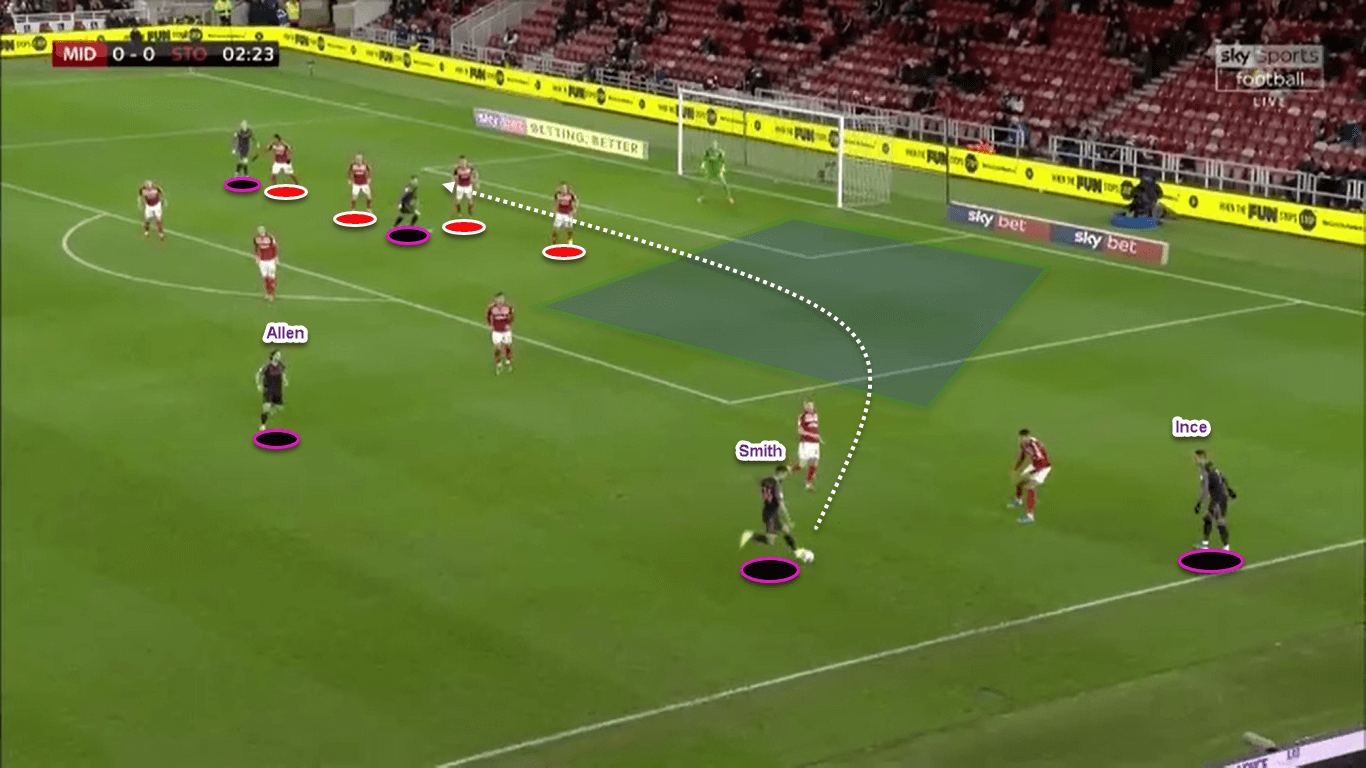
Here is another example of Stoke’s right-sided triangle that failed to work its way through into a more dangerous position for chance creation.
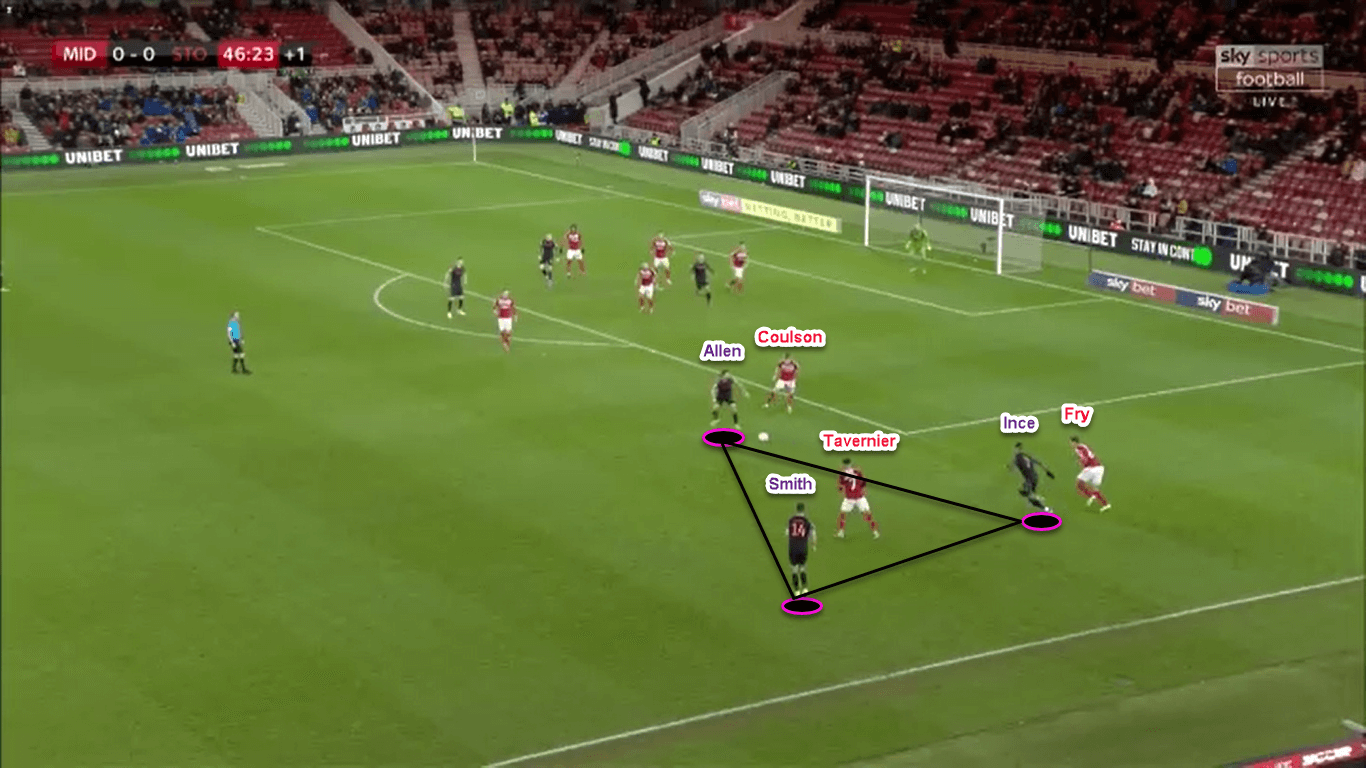
Middlesbrough’s first-half struggles
Even though, as explained in the previous paragraphs, Stoke did not create many clear cut chances in the first half, at least the away team had an intention to attack. Conversely, the home team’s tactics were very conservative and pragmatic in the first half. The Riversiders’ xG of the first half was as low as 0.29 since they only took a single shot at goal.
In situations when Middlesbrough did have the courage to go forward their attacking approach was either too direct or lacking penetration when possession play was adopted. When the home side tried to play out from the back under pressure, it usually did not work with Stoke City being able to cut out the passing lanes. As a result, the Boro had to go for a more direct approach.
The example below highlights Middlesbrough’s struggles to play from the defence when under pressure. In this situation, all three centre-backs were positioned very narrowly which meant Stoke’s first line of press stayed also very narrow. Howson, on the ball, tried to find his teammate in midfield but the pass was cleverly intercepted by Allen.
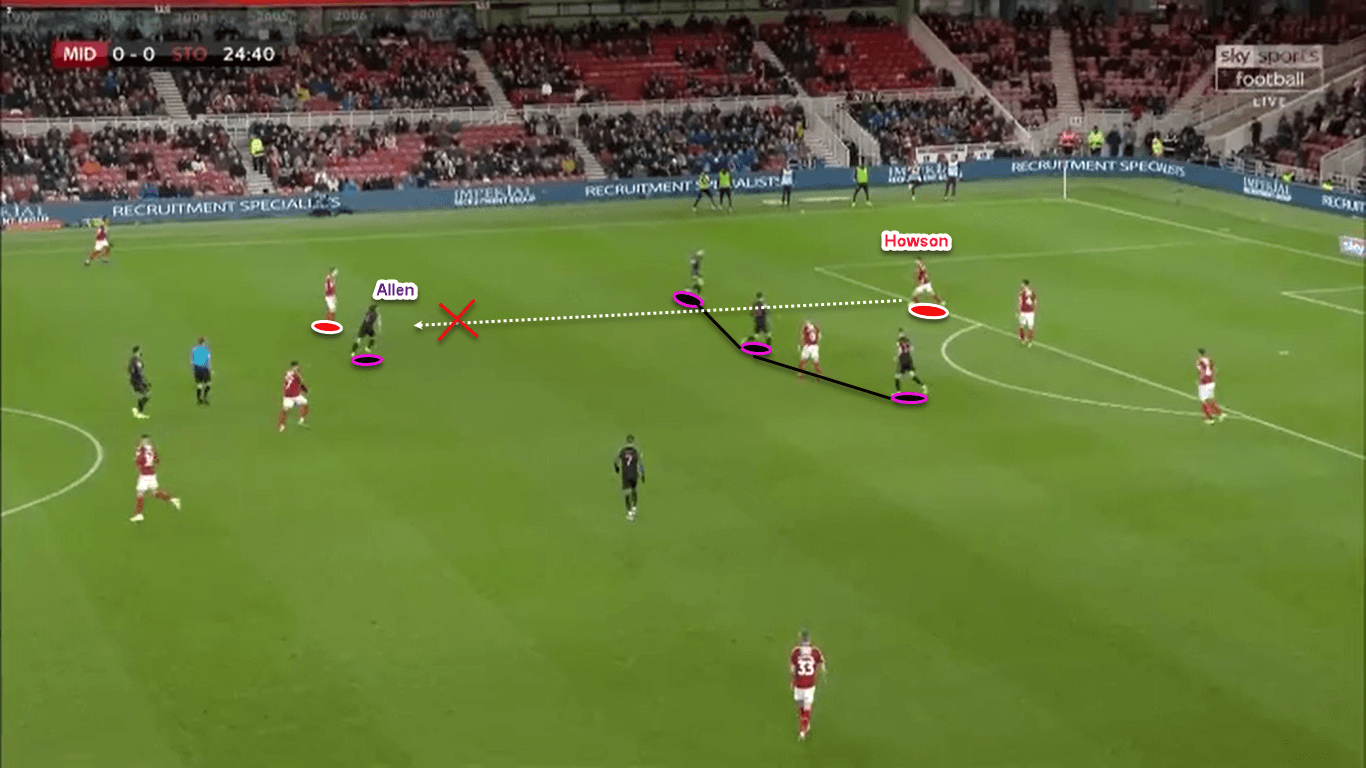
In those moments when the visitors retrieved deeper into a mid-block, the home team still found it hard to make any purposeful use of the ball. Below we can see such an example in a sequence. In the first image, it can be seen how narrow the Stoke’s midfield is. Tavernier is positioned in behind Allen and Ince with the latter glancing over his shoulder in order to intercept a potential through ball. This narrow midfield unit of Stoke forces Saville to play the ball to Coulson.
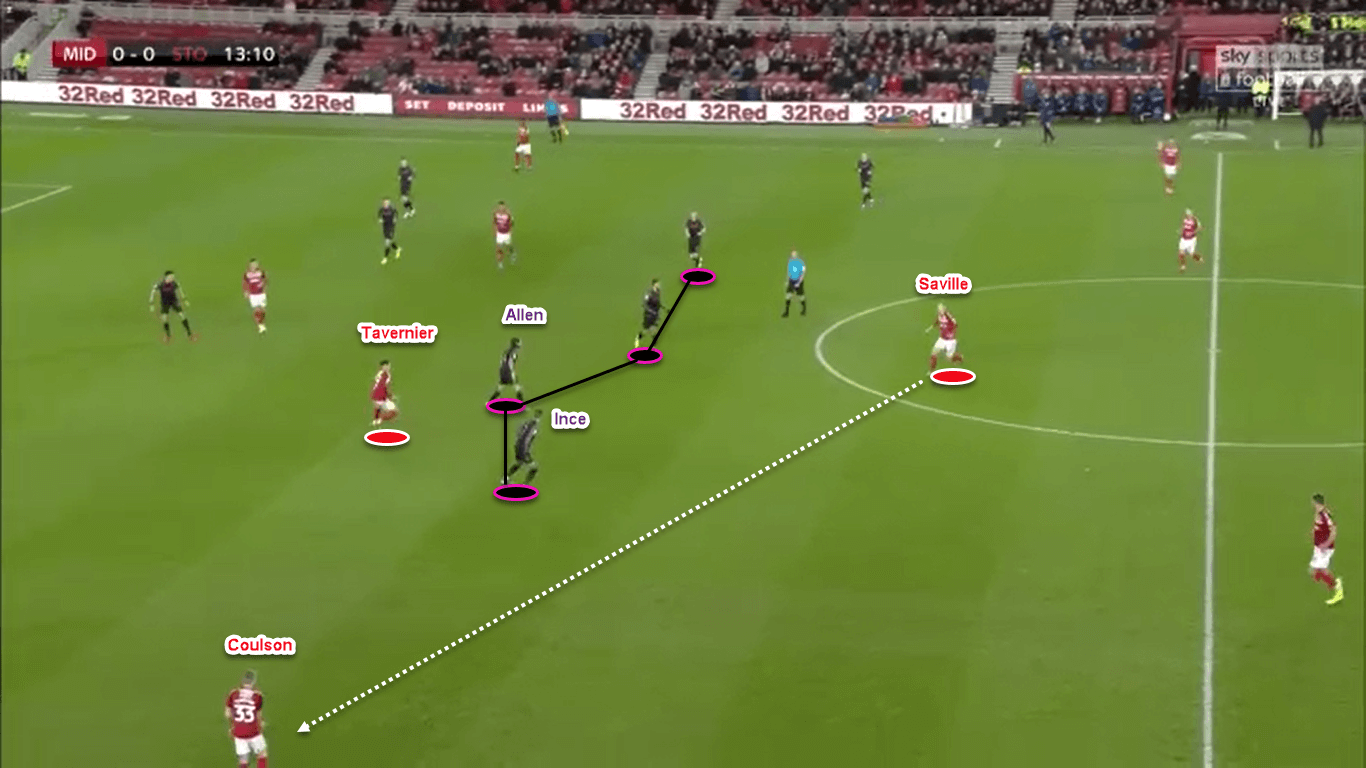
When the ball eventually reaches the left wing-back, Stoke’s midfield unit had already shifted to the ball side trying to prevent its further progression. The problem here is that no one of Middlesbrough’s players tries to move into the highlighted area between the full-back and centre-back. Both central midfielders Tavernier and Saville are positioned laterally which prevents any possible vertical ball progression which would have been possible with a diagonal pass from Coulson into the highlighted area.
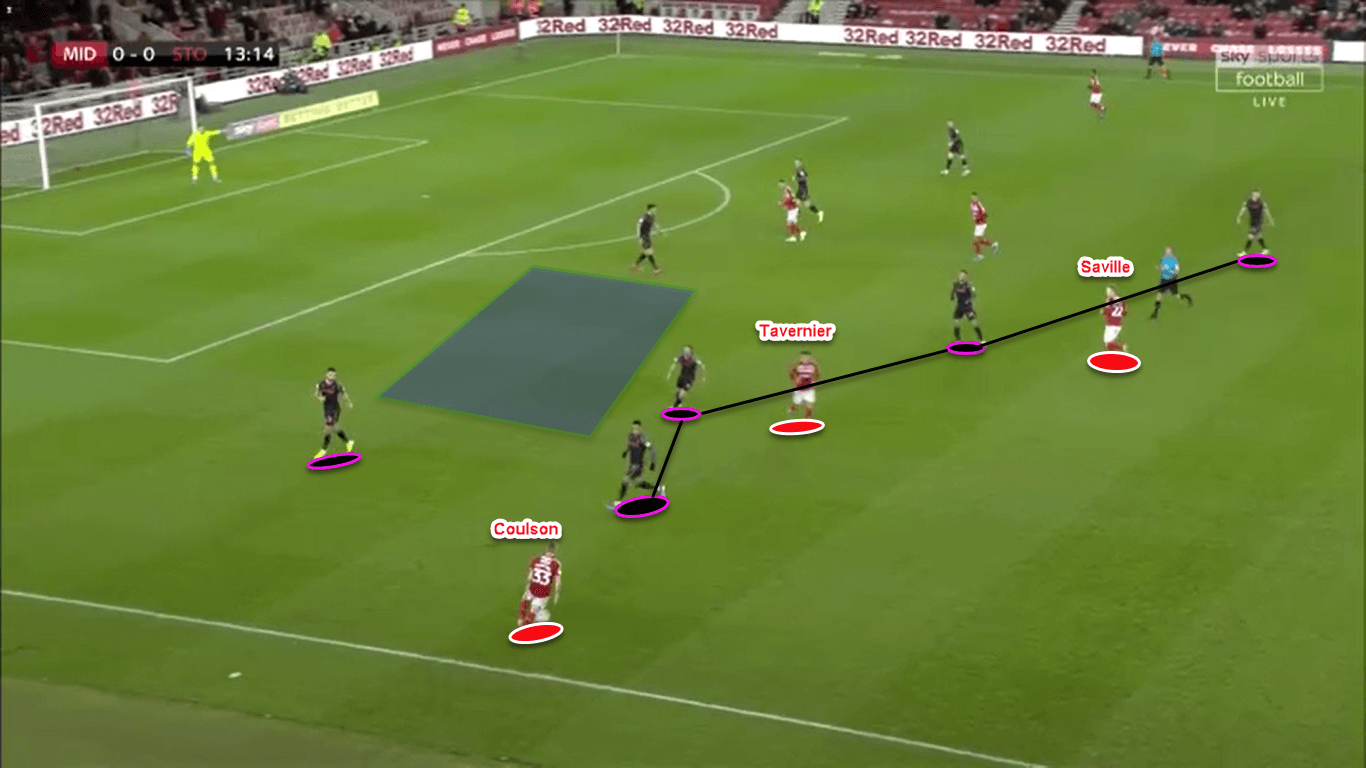
Consequently, the ball was played back to the centre of midfield where Tavernier was immediately closed down by four Stoke City players.
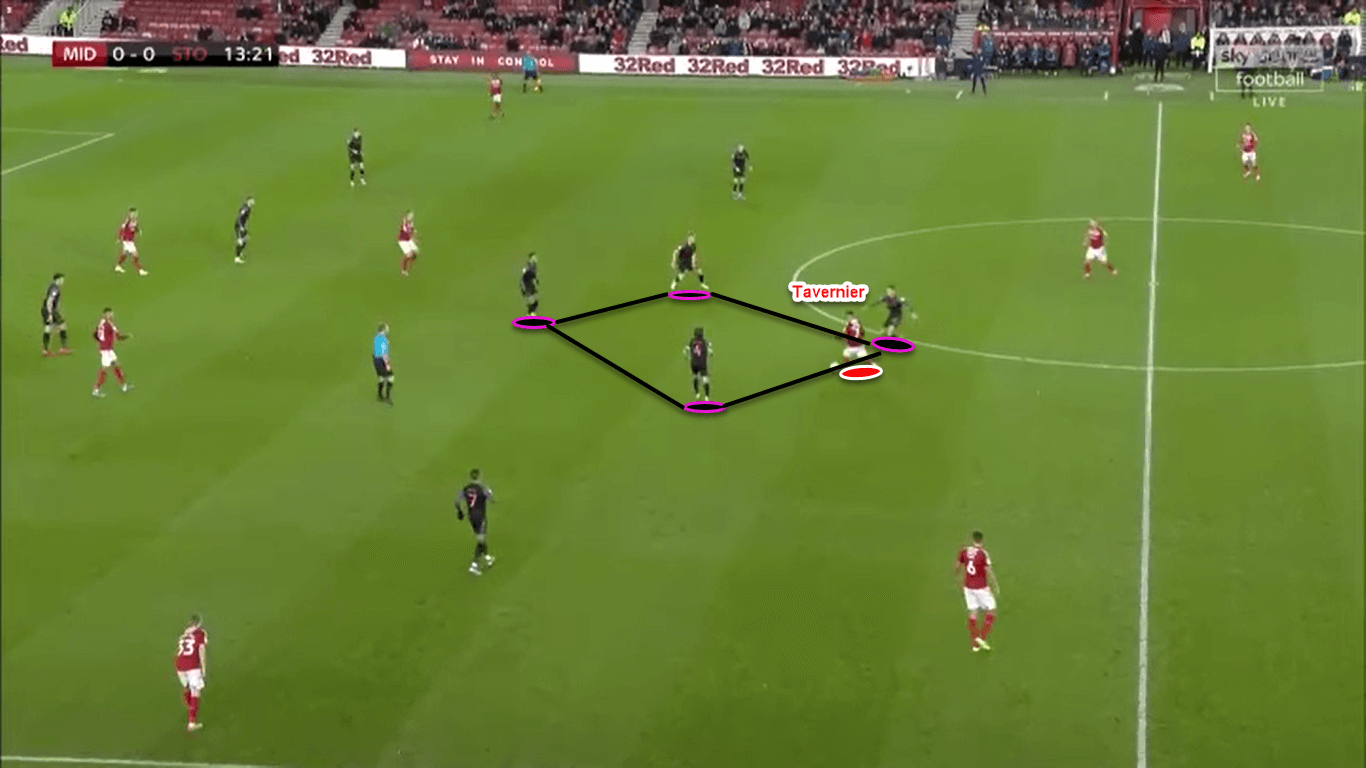
Half-time adjustments
In relation to the tactical changes that we will touch upon later, Middlesbrough also came out in the second half with a more aggressive attitude. Adding to what could be seen with a naked eye, the statistical metric of Passes Allowed Per Defensive Action (PPDA) further backs it up. In the second half, the home team allowed the visitors to perform 6.7 uncontested passes when playing out from the back compared to 8.5 in the first half. It indicates Middlesbrough’s greater level of defensive intensity in the second half.
The example of it can be seen below in a sequence of images. The first one illustrates how the home team made themselves more ball oriented congesting the part of the pitch where the ball was and at the same time executing it higher up the pitch forcing the opposition to play it long.
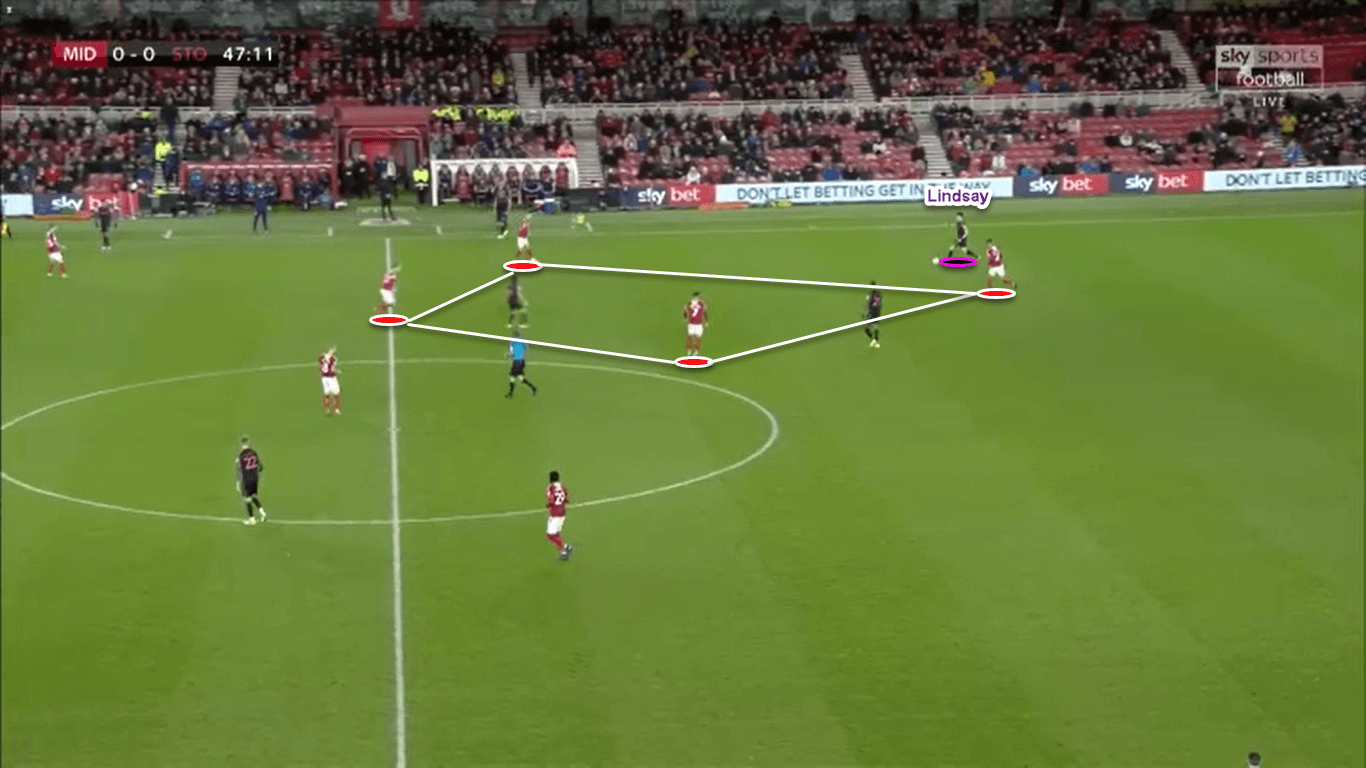
This increased defensive intensity and pressing higher up the pitch meant that the Stoke players would have to come deeper into their own half to collect the ball if playing out from the back rather than kicking it long was still the preference. Here we can see how Allen was surrounded by the three opposition’s players while Coulson raised his anticipation levels and read the pass to Ince.
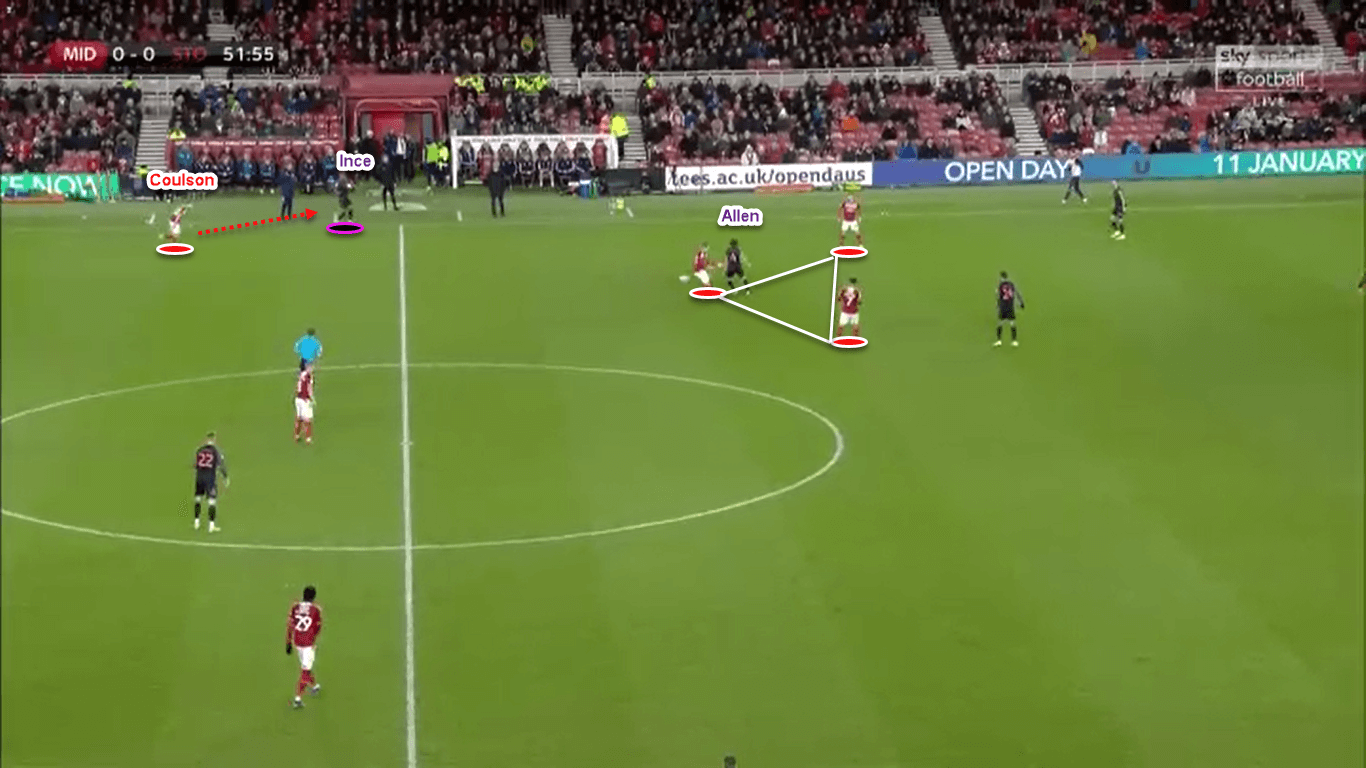
Another scene of Middlesbrough’s increased defensive intensity is displayed below. The right-winger Ince had to drop very deep to collect the ball with his back facing the opponent’s goal. Allen was also looked after carefully which made the life a lot harder for the visitors.
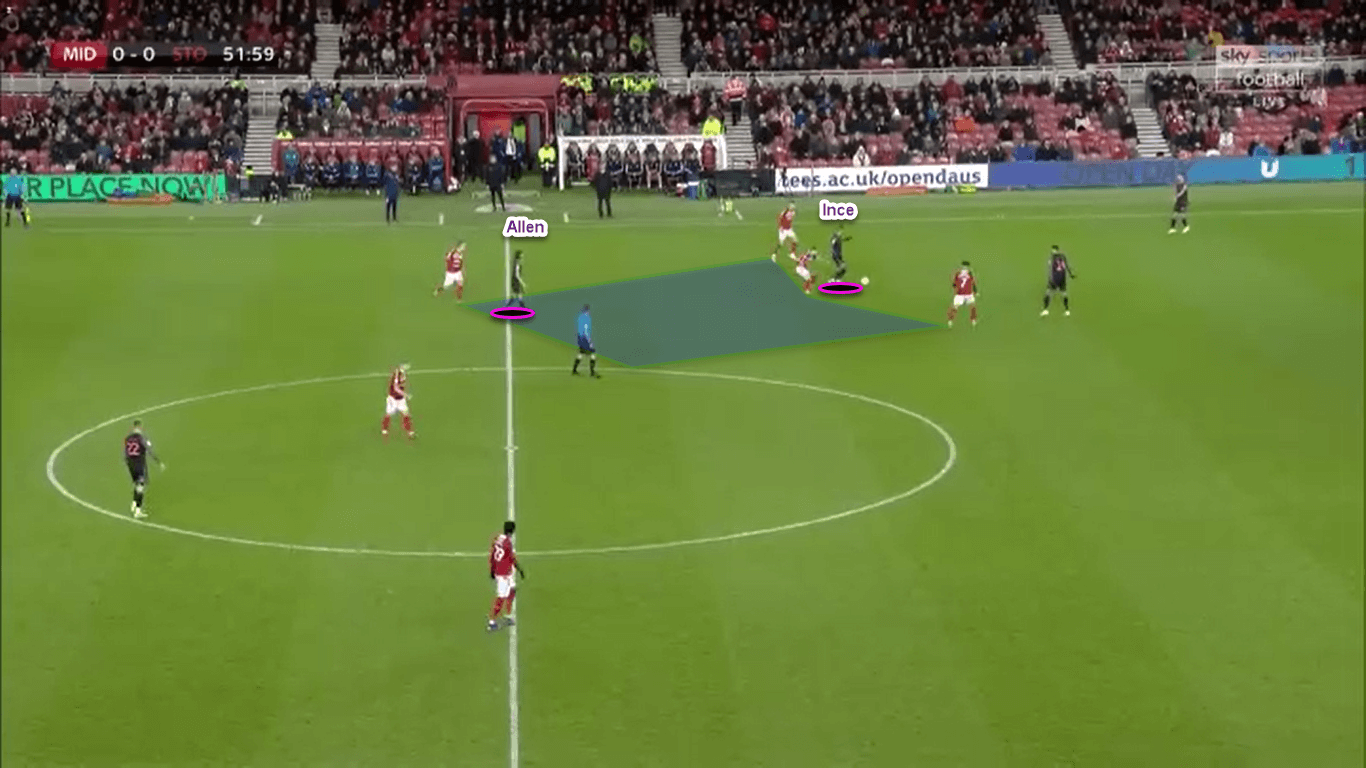
Funnily enough, the goal that the home team conceded came from a long ball that was played in behind the Boro’s centre-back who was outpaced; however, this higher defensive intensity approach paid the dividends later on. Stoke’s attacks per minute ratio decreased from 0.53 to 0.42 in the second half, as well as there was a 5% increase in long passes which later showed to be ineffective as the team suffered a defeat.
In addition to the intensity side of things, now it is time to look at the adjustments regarding the formation made by Woodgate that made the difference. His side started the game in a 3-5-2 formation that meant the only wide players were the wing-backs. Since Stoke City have two pacey and skilful wingers in Ince and McClean, it meant that both Middlesbrough’s wing-backs had to stay fairly deep in their own half. For this reason, any threat that might come from the play down the wings was restricted from the Middlesbrough’s point of view.
To address this issue and have more play happening down the wings, Woodgate switched to a four men defence. Howson was moved from the right-sided centre-back’s position to right-back which meant Spence (right wing-back) was pushed forward into right winger’s position. Coulson, on the other side, moved into left-back. Fletcher remained up top whilst the second striker Walker moved to the left-wing. Now Spence had more license to bomb forward as it will be seen below.
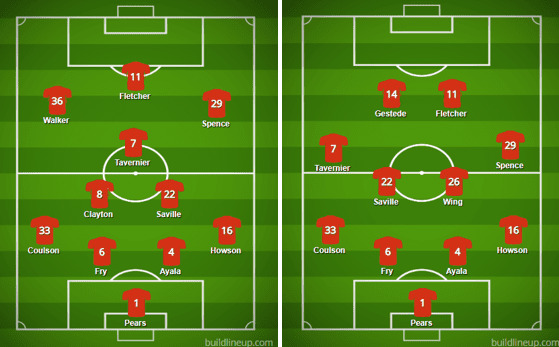
As it can be seen in this image, Stoke have three players on the ball side (Smith, Clucas and Ince) which means the home team has to match it in order to avoid numerical inferiority. This meant one of the centre-backs, in this case Fry, had to step out to cover the opposition’s winger (Ince). What is more, the Potters positioned two of their players near the penalty box which means the whole backline is pinned. Allen pinned Saville in the centre of midfield, whereas Spence was pinned by McClean. When Stoke switched the play to the opposite side where Ward was, the left-back had acres of space in front of him. It meant that there was a possibility of a two versus one situation if Spence stepped out and McClean drifted to the side.
Conversely, even if the ball was won back by the home team, their only wide player on the right would have been very deep and ineffective on a counterattack. The switch to a back four meant that there are two wide players now which gives it more chance to catch the opposition on the break down the flanks.
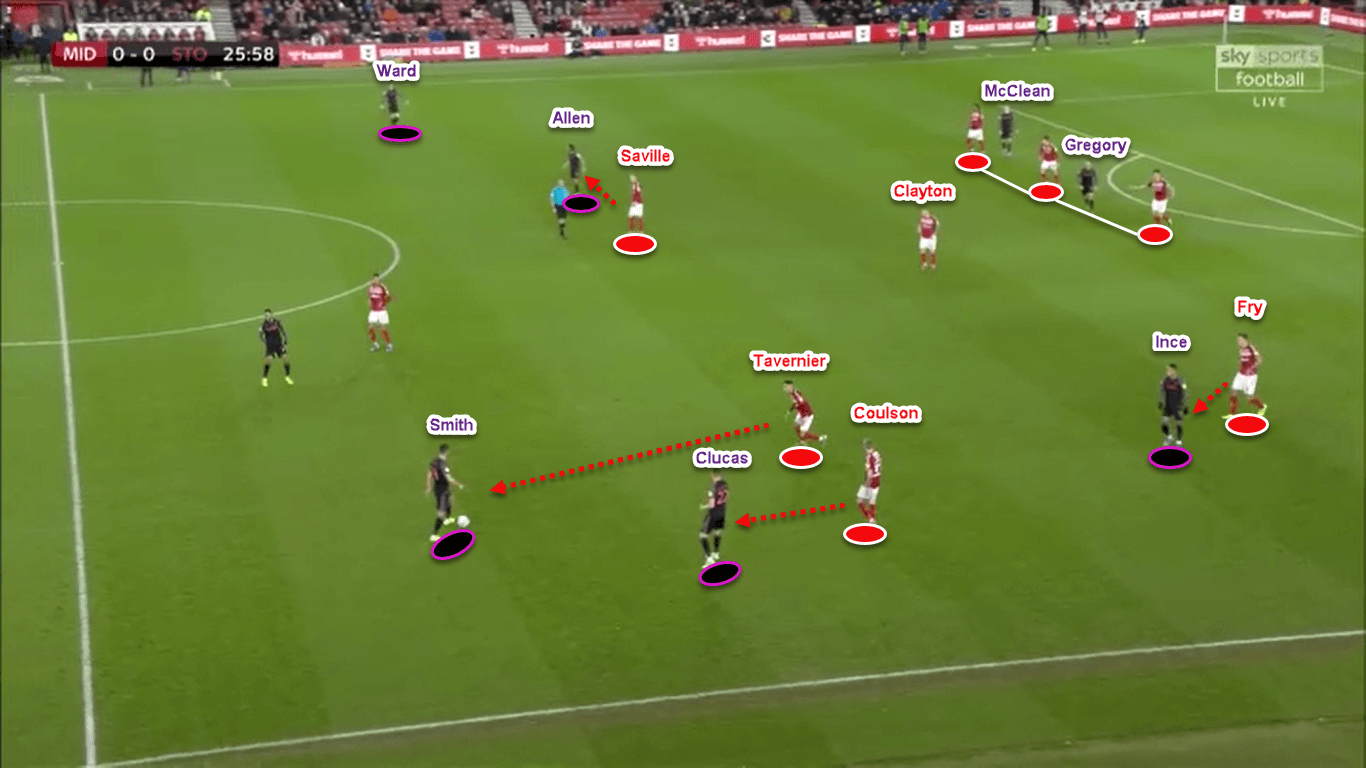
Below we can see an example when Middlesbrough had an additional wide player higher up the pitch after switching to a back four. In general, this tactical switch went in hand with the Boro’s increased attacking ratio from 0.19 to 0.48 per minute.
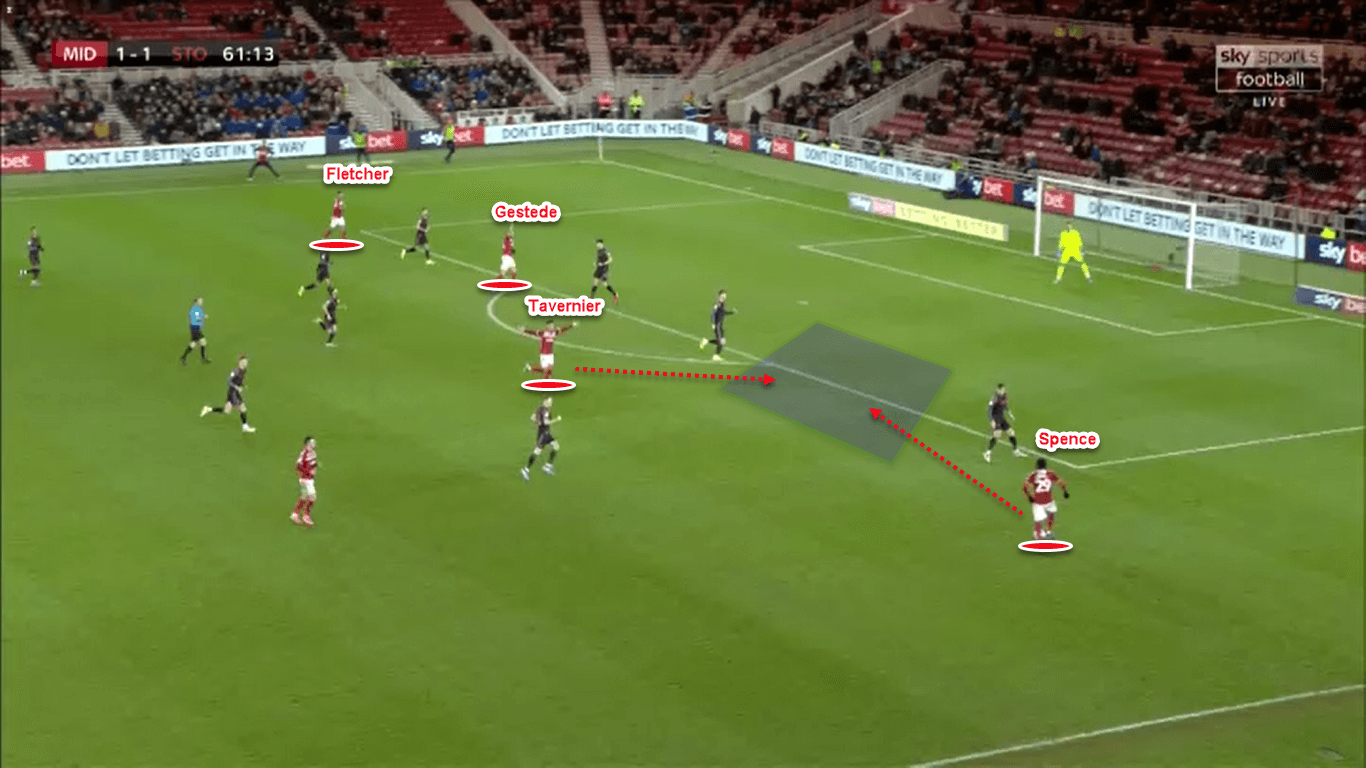
Conclusion
As this analysis explained, the relegation ‘six-pointer’ proved to be an interesting encounter. The first half saw only one team trying to create chances while the other adopted a very negative approach. The second half adjustments made by Woodgate disturbed Stoke’s possession play which led to another defeat after going in front first. The Potters remain in the relegation zone and O’Neill will have to work a treat to escape the relegation. On the other side, a negative approach adopted by the Riversiders in the first half shows why they are the lowest-scoring team in the EFL Championship. A more positive approach and tactical flexibility must be shown to climb the positions in the table.

If you love tactical analysis, then you’ll love the digital magazines from totalfootballanalysis.com – a guaranteed 100+ pages of pure tactical analysis covering topics from the Premier League, Serie A, La Liga, Bundesliga and many, many more. Buy your copy of the December issue for just ₤4.99 here





Comments